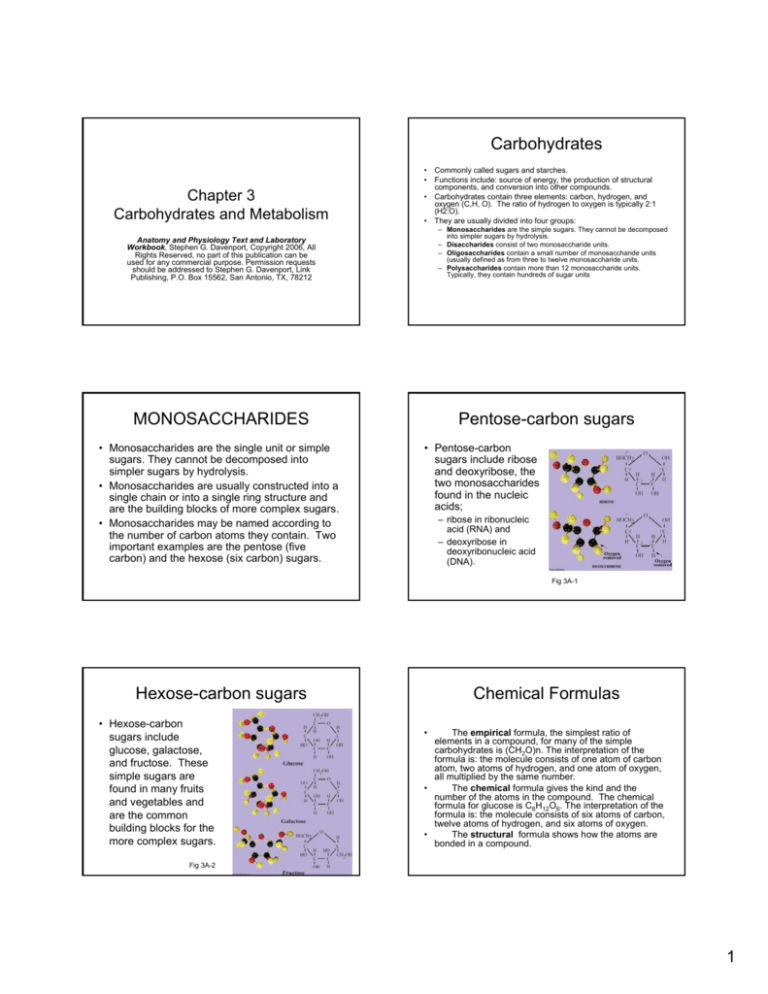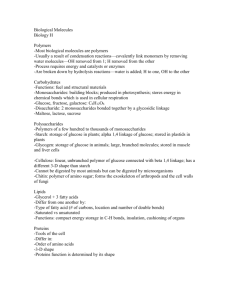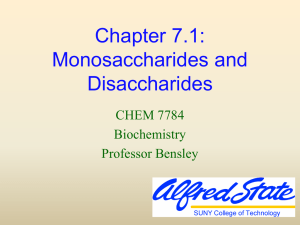
Carbohydrates
•
•
Chapter 3
Carbohydrates and Metabolism
•
•
– Monosaccharides are the simple sugars. They cannot be decomposed
into simpler sugars by hydrolysis.
– Disaccharides consist of two monosaccharide units.
– Oligosaccharides contain a small number of monosaccharide units
(usually defined as from three to twelve monosaccharide units.
– Polysaccharides contain more than 12 monosaccharide units.
Typically, they contain hundreds of sugar units
Anatomy and Physiology Text and Laboratory
Workbook, Stephen G. Davenport, Copyright 2006, All
Rights Reserved, no part of this publication can be
used for any commercial purpose. Permission requests
should be addressed to Stephen G. Davenport, Link
Publishing, P.O. Box 15562, San Antonio, TX, 78212
MONOSACCHARIDES
• Monosaccharides are the single unit or simple
sugars. They cannot be decomposed into
simpler sugars by hydrolysis.
• Monosaccharides are usually constructed into a
single chain or into a single ring structure and
are the building blocks of more complex sugars.
• Monosaccharides may be named according to
the number of carbon atoms they contain. Two
important examples are the pentose (five
carbon) and the hexose (six carbon) sugars.
Commonly called sugars and starches.
Functions include: source of energy, the production of structural
components, and conversion into other compounds.
Carbohydrates contain three elements: carbon, hydrogen, and
oxygen (C,H, O). The ratio of hydrogen to oxygen is typically 2:1
(H2:O).
They are usually divided into four groups:
Pentose-carbon sugars
• Pentose-carbon
sugars include ribose
and deoxyribose, the
two monosaccharides
found in the nucleic
acids;
– ribose in ribonucleic
acid (RNA) and
– deoxyribose in
deoxyribonucleic acid
(DNA).
Fig 3A-1
Hexose-carbon sugars
• Hexose-carbon
sugars include
glucose, galactose,
and fructose. These
simple sugars are
found in many fruits
and vegetables and
are the common
building blocks for the
more complex sugars.
Chemical Formulas
•
The empirical formula, the simplest ratio of
elements in a compound, for many of the simple
carbohydrates is (CH2O)n. The interpretation of the
formula is: the molecule consists of one atom of carbon
atom, two atoms of hydrogen, and one atom of oxygen,
all multiplied by the same number.
•
The chemical formula gives the kind and the
number of the atoms in the compound. The chemical
formula for glucose is C6H12O6. The interpretation of the
formula is: the molecule consists of six atoms of carbon,
twelve atoms of hydrogen, and six atoms of oxygen.
•
The structural formula shows how the atoms are
bonded in a compound.
Fig 3A-2
1
Lab Activity 1
Molecular Model Kit
Structural Formulas and Isomers
•
•
The structural formulas for
glucose, galactose, mannose,
and fructose are shown in the
following illustration. The
structural formula is the “blueprint” of the compound.
Isomers are compounds that
have the same chemical
formulas. For example, the
chemical formula of C6H12O6
can be expressed as four
structural isomers: glucose,
galactose, mannose, and
fructose.
Fig 3A-3
Construct models of glucose and fructose
DISACCHARIDES
• Disaccharides may be
considered as double
sugars because they are
formed from the union of
two monosaccharides.
• Important disaccharides
include
OLIGOSACCHARIDES
•
•
– sucrose (glucose + fructose
or common table sugar),
– lactose (glucose +
galactose or milk sugar),
– maltose (glucose +
glucose).
•
Oligosaccharides are formed
from the union of three to
twelve monosaccharides.
They are common in the
formation of oligosaccharideglycoproteins commonly found
in the extracellular
phospholipid bilayer of the cell
membrane.
Functions of membrane bound
oligosaccharide-glycoproteins
include cell surface recognition
(especially for hormones and
other cells), and cell surface
antigenicity (such as the
antigens for blood groups).
Fig 3A-5
Fig 3A-4
POLYSACCHARIDES
• Polysaccharides are formed from the
union of twelve or more monosaccharides.
Common polysaccharides include
glycogen and starch.
Starch
•
Starch, a carbohydrate
produced by plants, typically
consists of thousands of
glucose units. In plants such
as corn and potato, glucose is
typically stored in structural
units called starch grains.
– Cooking (heat) denatures the
starch grains into
macromolecules, which when
eaten are digested
(hydrolyzed) to glucose.
Glucose then enters the blood
by crossing the intestinal
lining.
Fig 3A-6
2
Carbohydrate Dehydration
Synthesis
Glycogen
• Glycogen, a carbohydrate
produced by animals,
typically consists of
thousands of glucose
units.
• A molecule of glycogen is
produced by dehydration
synthesis involving
thousands of glucose
units and is commonly
stored as glycogen
granules in liver and
muscle tissue.
• Dehydration synthesis is the reaction that joins smaller
molecules into a larger molecule (synthesis) and
produces water (dehydration). In the formation of larger
sugar molecules (such as the formation of a
disaccharide from two monosaccharides) the union of
the two smaller sugars is by an enzymatically driven
reaction called dehydration synthesis.
Fig 3A-7
Fig 3A-8
Carbohydrate Hydrolysis
•
The enzymatically driven reaction that splits a larger
sugar molecule into smaller sugar molecules and also
splits and utilizes a molecule of water is called
hydrolysis. The following illustration shows the reaction
that splits the larger disaccharide, sucrose, into two
smaller monosaccharides, glucose and fructose.
Glycoaminoglycans (GAGs),
•
The mucopolysaccharides, now
commonly called glycoaminoglycans
(GAGs), the bind large amounts of water.
They produce the viscous, lubricating
properties of mucus (which led to the
original name of mucopolysaccharides)
and the gel-like ground substance found
among the fibers of connective tissues.
Fig 3A-9
Glycoaminoglycans
• The glycoaminoglycans are long,
unbranched charged polysaccharide
chains composed of repeating
disaccharide units.
Glycoaminoglycans
Fig 3A-10
Fig 3A-13
Glycoaminoglycans bind together the collagen fibers of
tendon to form a functional unit.
Fig 3A-11
3
Glycoaminoglycans
GLYCOPROTEINS
Glycoproteins are proteins that are bonded to a
carbohydrate chain (oligosaccharide).
Glycoproteins are commonly found associated with
cell membranes, as part of extracellular matrix, and the
mucins of the digestive, urinary and reproductive tracts.
Fig 3A-16
Water is an effective lubricant and shock absorber.
In synovial fluids pressure causes water to move
away for its associated hydrophilic molecule
(GAG).
Fig 3A-17
Fig 3A-15
Glucose from Dietary
Carbohydrates
CARBOHYDRATE
METABOLISM
• Major sources of dietary carbohydrates are starch (from
plant materials), glycogen (from animal tissue), and
disaccharides such as sucrose (table sugar) and lactose
(in milk).
• Digestion converts all multi-unit sugars to
monosaccharides, which include glucose, fructose, and
galactose. The monosaccharides are absorbed by the
intestine and transported by the blood to the liver. The
liver converts all non-glucose monosaccharides to
glucose, the monosaccharide commonly referred to as
“blood sugar.”
• The liver metabolizes some of the glucose and the rest
circulates to peripheral tissues.
Lab Activity 4 - Raw Potato
• Cut a thin slice of the raw potato and place
on a clean microscope slide.
Fig 3A-18
Fig 3A-19
4
Lab Activity 5 - Cooked Potato
• Cut a thin slice of the cooked potato and
place on a clean microscope slide.
Lab Activity 6 - Liver Glycogen
• High power and oil
immersion photographs
of liver with glycogen
present. Glycogen is a
storage macromolecule
formed of repeating units
of glucose.
Fig 3A-22
Fig 3A-20
Fig 3A-21
GLUCOSE CATABOLISM
• In the well-fed state, the major sources of glucose are
dietary, mostly as the end product from the digestion of
disaccharides (such as cane sugar) and polysaccharides
(such as starch).
•
In the fasting state, the breaking down of the liver’s
glycogen, glycogenolysis, into glucose units helps
maintain blood glucose levels. Also, glucose can be
manufactured from non-glucose substances such as fats
and proteins; a process called gluconeogenesis.
•
The catabolism (breaking down) of glucose is mostly
for the production of energy rich ATP. When glucose is
oxidized, some of the energy found in its chemical
bonds, is transferred to high-energy phosphate bonds in
the formation of the energy rich molecule adenosine
triphosphate (ATP). The chemical reaction may be
summarized as follows:
• High power and oil
immersion photographs
of liver with glycogen
absent. In this tissue
preparation the glycogen
was removed by the
enzyme amylase.
Fig 3A-23
GLUCOSE CATABOLISM
Fig 3A-24
GLUCOSE ANABOLISM
• A major role of glucose in the body is catabolism as a
fuel. In glucose anabolism, the constructive phase of
glucose metabolism, three major process are
gluconeogenesis, glycogenesis, and glycogenolysis.
• Gluconeogenesis
– Glucose can be constructed from non-carbohydrate sources,
such as proteins and fats, by a process call gluconeogenesis.
Gluconeogensis occurs when there is a low glucose level,
perhaps due to starvation, fasting, or a low carbohydrate diet.
• Glycogenesis
– If glucose levels are high, as seen in increased blood sugar after
a carbohydrate rich meal, glucose can be assembled for storage
as the polysaccharide glycogen by a process called
glycogenesis.
• Glycogenolysis
– Glycogen storage is catabolized to release glucose, a process
called glycogenolysis, when blood sugar begins to decrease.
5







